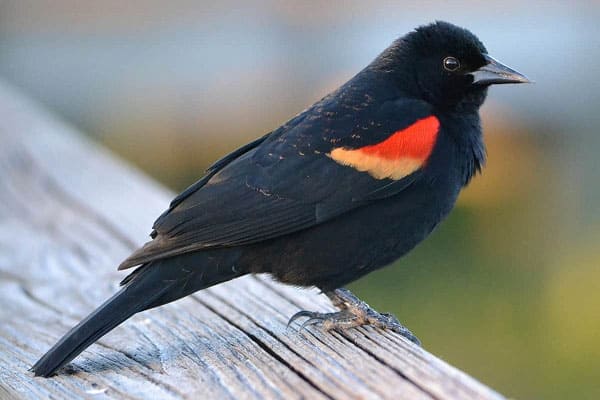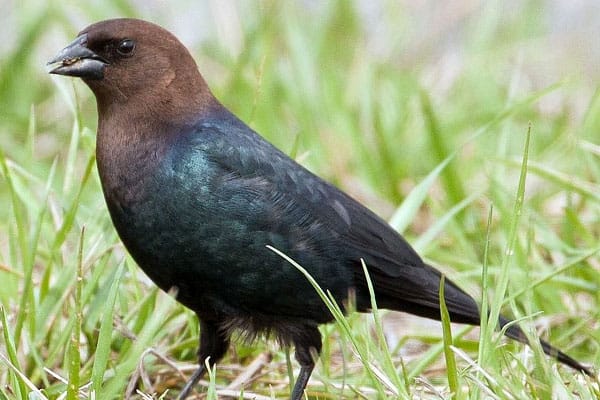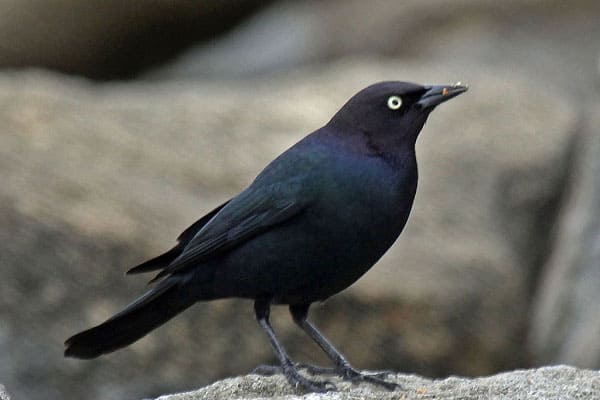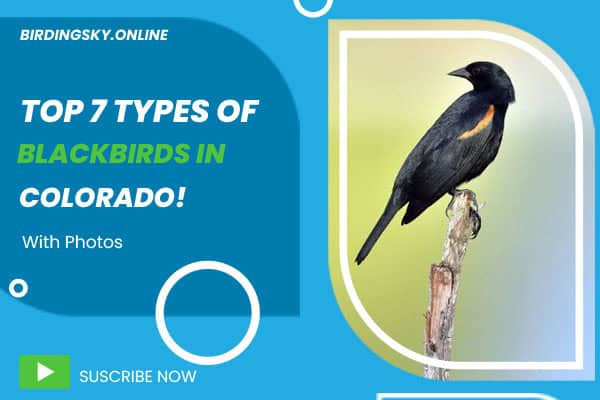Have you ever wondered how many types of blackbirds can be found in Colorado? We are here to uncover the fascinating array of these avian wonders that call the Centennial State home. From the iconic red-winged blackbird to the lesser-known Brewer’s blackbird, Colorado boasts a rich tapestry of blackbird species that can captivate anyone’s imagination.
Main points to note:
- Colorado is home to a diverse range of blackbird species
- The red-winged blackbird is one of the most recognizable blackbird species in Colorado
- The European starling, though not native to North America, is a common sight in Colorado
- The brown-headed cowbird is a unique species known for its breeding behavior
- The downy woodpecker adds diversity to Colorado’s bird community
1. Red-winged Blackbirds of colorado
If you’ve ever taken a stroll through the picturesque landscapes of Colorado, chances are you’ve encountered the magnificent red-winged blackbird. With its vibrant red shoulder patches and distinctive black feathers, this stunning bird is a true icon of Colorado’s avian diversity.
Red-winged blackbirds (Agelaius phoeniceus) are abundant throughout the state, gracing wetlands, marshes, and open fields with their presence. Their bold and melodious songs fill the air, announcing their territorial boundaries and attracting mates.
The red-winged blackbirds of colorado is primarily a ground-nesting species, building its nests amongst tall grasses or reeds, often near water sources. Their nests are intricately woven structures, carefully constructed using plant materials and lined with softer materials like grass and leaves. These nests provide a safe haven for the blackbird’s eggs and young.

During the breeding season, male red-winged blackbirds display their vibrant red shoulder patches as a means of asserting dominance and attracting female mates. These patches serve as a visual cue to other birds, warning them to keep their distance or face potential aggression.
Habitat
Red-winged blackbirds inhabit a diverse range of habitats in Colorado, including wetlands, meadows, and agricultural fields. They are adaptable birds that can thrive in both natural and human-altered landscapes.
Wetlands play a crucial role in providing the necessary resources for red-winged blackbirds. The dense vegetation found in these areas offers ample nesting sites and abundant food sources, such as insects, spiders, seeds, and berries.
Behavior
Red-winged blackbirds are highly social birds, often seen in large flocks during the non-breeding season. These flocks provide protection, increased foraging opportunities, and communal roosting sites.
The red-winged blackbird’s diet mainly consists of insects, seeds, grains, and fruits. They forage on the ground or in low vegetation, using their sharp beaks to extract food from various sources.
Despite their beauty and fascinating behaviors, red-winged blackbirds can be highly territorial during the breeding season. Males vigorously defend their territories, engaging in aggressive displays and vocalizations to deter potential threats.
Unique Features
Aside from their striking red shoulder patches, red-winged blackbirds exhibit other unique features that make them stand out in Colorado’s bird community.
- Males – Male red-winged blackbirds in colorado have a distinctive black body, glossy feathers, and prominent red shoulder patches. These patches can vary in size and shape individually, allowing for visual recognition within their communities.
- Females – Female red-winged blackbirds have a more subdued appearance, with streaked brown feathers that provide excellent camouflage for their nests.
- Vocalizations – Both males and females produce a wide array of calls and songs. Their vocal repertoire includes a distinctive “conk-la-ree” song, which resonates across their territories.
The red-winged blackbird’s stunning appearance, captivating behaviors, and diverse habitats make it a beloved symbol of Colorado’s rich birdlife. Whether you spot them soaring through the skies or perched among the reeds, these magnificent birds never fail to leave a lasting impression.
2. European Starling
Colorado’s blackbird population is not limited to native species. The European starling, although not originally from North America, has made its mark as a notable resident of Colorado’s avian community. With its striking iridescent plumage and captivating melodious song, the European starling adds a touch of allure to the blackbirds found in the state.
Originally introduced to North America in the late 19th century, European starlings quickly adapted to their new environment and spread across the continent, including Colorado. Today, they are a common sight in urban areas, as well as agricultural and suburban landscapes.

The European starling is known for its distinctive appearance. Their black plumage is adorned with iridescent green and purple hues, which shimmer in the sunlight. These birds also display yellow beaks and dark eyes, further enhancing their striking visuals. Their melodious song, filled with mimicry and an array of notes, adds a pleasant ambiance to any outdoor setting.
“The European starling is truly an impressive addition to Colorado’s blackbird population. Their vibrant plumage and beautiful songs make them a joy to observe in the wild.” – Michael Johnson, Colorado Bird Enthusiast
European starlings are adaptable birds and can be found in a variety of habitats across Colorado. They are often seen in flocks, foraging for food on the ground or in trees. Their diet includes insects, berries, seeds, and even small vertebrates. These birds are also known to outcompete other native bird species for resources, at times impacting local ecosystems.
Despite their non-native status, European starlings have carved out a place in Colorado’s avifauna. Their distinctive appearance and charming songs make them a fascinating addition to the diverse blackbird species found in the state.
3. Brown-headed Cowbird
The brown-headed cowbird is a fascinating blackbird species that can be found in Colorado. With its distinctive brown head and sleek black plumage, this bird is a common sight in various habitats across the state. Despite its unassuming appearance, the brown-headed cowbird has a unique breeding strategy that sets it apart from other bird species.

Cowbird species in CO
The brown-headed cowbird is well-known for its brood parasitism behavior. Rather than building its own nest and raising its young, the cowbird lays its eggs in the nests of other bird species. This behavior allows the cowbird to offload parental responsibilities onto unsuspecting hosts.
“This brood parasite lays its eggs in the nests of other bird species, leaving the responsibility of raising its young to unsuspecting hosts.”
The sequel follows….
Once the cowbird egg is laid in the host’s nest, it hatches and the cowbird chick often outcompetes the host’s own offspring for food and attention. This strategy ensures the survival of the cowbird at the expense of the host species. While this may seem detrimental to the host, cowbird parasitism can also provide opportunity for certain bird species to adapt and evolve.
Cowbird brood parasitism can have significant impacts on the populations of other bird species, especially those with smaller nests or less parental care. However, some bird species have developed defenses against cowbird parasitism. These defenses include recognizing and removing cowbird eggs from their nests or abandoning nests that have been parasitized.
To gain a better understanding of the brown-headed cowbird and its breeding behavior, scientists and bird enthusiasts in Colorado have conducted extensive research and monitoring efforts. By studying the interactions between cowbirds and their hosts, researchers hope to unravel the complexities of brood parasitism and its implications for Colorado’s avian ecosystem.
The Impact of Cowbird Parasitism on Other Bird Species
While cowbird brood parasitism can have negative effects on the populations of certain bird species, it also presents opportunities for adaptation and evolution. Some bird species have developed strategies to combat cowbird parasitism, such as recognizing and removing cowbird eggs from their nests or abandoning parasitized nests. These defense mechanisms have allowed these species to persist in the face of cowbird parasitism.
When it comes to the impact of cowbird parasitism on Colorado’s avifauna, the specifics can vary depending on the host species and their ability to defend against or tolerate cowbird eggs in their nests. Research has shown that some bird species have experienced declines in population due to cowbird parasitism, while others have been able to adapt and coexist with the cowbirds.
The Importance of Conservation Efforts
Understanding the impact of cowbird parasitism on Colorado’s bird species is crucial for conservation efforts. By identifying the bird species most vulnerable to cowbird parasitism and implementing targeted conservation strategies, we can work towards maintaining and restoring healthy bird populations in the state.
Conservation efforts may include creating and maintaining suitable habitat for host species, reducing cowbird populations through targeted management actions, and monitoring the impact of cowbird parasitism on vulnerable bird species.
The brown-headed cowbird is a unique blackbird species with fascinating breeding behavior. Its brood parasitism strategy and the interactions with host species in Colorado raise important questions about the dynamics of avian communities. By studying and protecting the diversity of blackbirds species in Colorado, we can contribute to the conservation of these remarkable birds and the ecosystems they inhabit.
4. Downy Woodpecker
Though not a blackbird in the traditional sense, the downy woodpecker is a valuable member of Colorado’s bird community. With its distinctive black-and-white plumage and drumming behavior, the downy woodpecker adds diversity to Colorado’s avian landscape.
The downy woodpecker (Picoides pubescens) is a small woodpecker species found throughout Colorado. It is the most common and widely distributed woodpecker in North America, including the forests, parks, and backyard trees of Colorado.

The downy woodpecker displays sexual dimorphism, with males having a small red patch on the back of their heads. However, this characteristic is not always easy to discern in the field, making it important to rely on other identifying features.
This woodpecker species measures approximately 5.5 to 6.7 inches in length and has a wingspan of 9.8 to 11.8 inches. It weighs around 0.7 to 1 ounce and has a short, chisel-like bill that it uses to excavate holes in trees while foraging for insects and larvae.
Behavior and Habits
The downy woodpecker is known for its drumming behavior, which involves rapidly pecking on the trunks and branches of trees to establish territories and attract mates. This distinctive sound can be heard throughout Colorado’s woodlands.
Like other woodpecker species, the downy woodpecker also uses its bill to probe bark crevices and extract insects. It primarily feeds on ants, beetles, caterpillars, and other small invertebrates.
This woodpecker species is cavity-nesting, meaning it excavates its nesting holes in dead or decaying trees. These cavities also serve as a place for roosting during the cold winter months.
“The downy woodpecker’s drumming behavior is not only a territorial display but also serves as a form of communication between individuals within the species.” – Colorado Parks and Wildlife
Habitat and Range
The downy woodpecker is a versatile species that can be found in a variety of habitats, including deciduous forests, coniferous forests, woodlands, and even suburban areas with mature trees.
In Colorado, the downy woodpecker is found throughout the state, from the eastern plains to the western mountains. It is a year-round resident, adapting to the changing seasons by adjusting its foraging behaviors and utilizing different food sources.
| Habitat | Range |
|---|---|
| Deciduous forests | Eastern, central, and western Colorado |
| Coniferous forests | Rocky Mountains and western Colorado |
| Woodlands | Throughout Colorado |
| Suburban areas | Throughout Colorado |
Source: Colorado Parks and Wildlife
While the downy woodpecker may not be a blackbird, its presence in Colorado adds to the diversity of species and enriches the state’s bird-watching opportunities. Observing this charismatic woodpecker in action, with its energetic drumming and delicate foraging techniques, is a true delight for nature enthusiasts.
5. Dark-eyed Junco
The dark-eyed junco (Junco hyemalis) is a small songbird that can often be found in Colorado’s woodlands and mountains. With its contrasting dark eyes and pale underparts, the dark-eyed junco is a familiar sight, especially during the winter months. These charming blackbirds are a delight to observe and study, with their unique characteristics and behaviors.

The dark-eyed junco is a member of the sparrow family and belongs to the genus Junco. In Colorado, it is one of the most common junco species and can be seen year-round, although its population tends to increase during the colder months. These birds have a diverse range of plumage variations, with some individuals displaying predominantly gray feathers, while others feature rusty brown or white markings. This variation adds to the fascination and beauty of these birds.
One of the interesting behaviors of dark-eyed juncos is their habit of foraging on the ground. They can often be seen hopping and scratching the forest floor in search of seeds and small insects. This behavior makes them an integral part of the ecosystem, as they help control insect populations and disperse seeds.
Subspecies of Dark-eyed Juncos in Colorado
There are several subspecies of dark-eyed juncos that can be found in different regions of Colorado:
- Gray-headed Junco (Junco hyemalis caniceps): This subspecies is known for its gray head and back, contrasting with its white belly.
- White-winged Junco (Junco hyemalis aikeni): As the name suggests, this junco subspecies has distinctive white wing bars along with its gray plumage.
- Red-backed Junco (Junco hyemalis dorsalis): This subspecies has a reddish-brown back, adding a splash of color to its overall appearance.
Each subspecies has its own unique characteristics and can be found in specific habitats within Colorado.
“The dark-eyed junco is a fascinating bird species that demonstrates the incredible diversity of blackbirds in Colorado.”
Whether you’re an experienced birder or just starting to explore the world of birds, the dark-eyed junco is a species that can be easily spotted and appreciated. Its presence adds to the overall richness and beauty of Colorado’s avian population. Observing these blackbirds in their natural habitat provides a wonderful opportunity to connect with nature and gain a deeper understanding of the delicate balance of ecosystems.
Additional Resources:
- For more information on the dark-eyed junco and other bird species in Colorado, visit the Colorado Parks and Wildlife website.
- To learn more about bird-watching and bird identification, consider joining a local birding group or consulting field guides such as A Field Guide to the Birds of Colorado by Ted Floyd.
Turkey Vulture
While not a traditional blackbird, the turkey vulture plays a crucial role in Colorado’s avian ecosystem. These magnificent birds are a common sight soaring through the skies, using their keen eyesight to spot carrion from above. Turkey vultures are essential for maintaining the balance of nature by disposing of decaying animal matter, preventing the spread of disease.
One of the distinctive features of the turkey vulture is their featherless head, which is specially designed for their scavenging lifestyle. The lack of feathers prevents bacteria buildup while feasting on carrion. Instead of searching for live prey, these large blackbirds of Colorado rely on their highly developed sense of smell to locate carcasses, making them a unique species in the avian world.
Expert Quote:
“Turkey vultures are nature’s cleanup crew. Their ability to consume decaying animal matter reduces the risk of spreading diseases, ensuring a healthier environment for all species in Colorado.” – Dr. Ava Martinez, Avian Ecologist
Another interesting behavior of turkey vultures is their habit of congregating and roosting in large groups, referred to as a “wake” or “kettle.” These gatherings can include hundreds of individuals, creating an impressive sight as they circle high in the air, catching thermal updrafts to gain altitude.
While they may not possess the bold colors of blackbirds of colorado or the melodious songs of songbirds, turkey vultures are an integral part of Colorado’s diverse bird population. Their unique scavenging behavior and skillful flight make them a fascinating species to observe in the vast skies of Colorado.
6. American Crow
The American crow is a highly intelligent and adaptable blackbirds species that can be found throughout Colorado. These iconic birds are known for their distinct cawing calls, which are sharp and resonant, echoing through forests, fields, and cityscapes. American crows are sociable creatures that often gather in large groups, forming communal roosts where they sleep, communicate, and protect each other. Their black feathers gleam in the sunlight, making them easily recognizable among other bird species.

With their sharp beaks and strong feet, American crows are versatile foragers, feeding on a wide variety of food sources. They are opportunistic omnivores, consuming anything from insects and small animals to fruits, seeds, and even human leftovers. These adaptive feeding habits have allowed American crows to thrive in diverse environments, including urban areas where they scavenge for food discarded by humans.
Intelligence and Problem-Solving Abilities
American crows are renowned for their intelligence and problem-solving abilities. They have been observed using tools, such as sticks and wires, to extract food from hard-to-reach places. Additionally, these clever birds can recognize individual human faces, displaying a remarkable ability to remember and differentiate between people. Their cognitive skills and adaptability contribute to their success as a species in both natural and human-altered landscapes.
“American crows are highly intelligent creatures that exhibit remarkable problem-solving skills and demonstrate a sophisticated understanding of their environment.”
– Dr. John Peterson, Ornithologist
Habitat and Range
American crows have a wide habitat range, spanning from forests and woodlands to grasslands and urban areas. They are adaptable to various environments, and their presence can be seen across Colorado, from mountainous regions to city parks. These birds build their nests in trees, constructing intricate structures using twigs, bark, and other natural materials.
Check Our Previous Articles:
| Mousebirds (Family Coliidae) With Photos |
| 6 Small Birds with Long Beaks (With Photos) |
| 7 Owls in Arkansas (With Photos) |
Ecological Importance
American crows play a crucial role in Colorado’s ecosystem. As scavengers, they help to clean up carrion and decaying organic matter, preventing the spread of disease. Their foraging habits also contribute to seed dispersal, aiding in forest regeneration and plant diversity. Additionally, American crows have symbiotic relationships with other species, such as wolves and coyotes, as they follow these large predators to scavenge on their leftovers.
Conservation Status
The American crow is a common and widespread blackbirds, with a stable population in colorado. They are not currently listed as threatened or endangered, but their dependency on human-altered landscapes, such as urban areas, may expose them to potential threats. Ongoing conservation efforts aim to protect their habitats and ensure their long-term survival in Colorado.
| American Crow | Species Information |
|---|---|
| Scientific Name | Corvus brachyrhynchos |
| Family | Corvidae |
| Length | 16-21 inches |
| Wingspan | 32-39 inches |
| Weight | 12-21 ounces |
| Range | Throughout North America, including Colorado |
7. Brewer’s Blackbird
The Brewer’s blackbird is a remarkable blackbird species that can be found right here in Colorado. With its glossy black plumage and yellow eyes, this bird is a stunning sight to behold. It’s an exciting addition to the diverse community of blackbirds in Colorado.

Brewer’s blackbirds are known for their keen foraging skills. They frequently gather in large flocks, scouring fields and open areas for insects, seeds, and fruits. You might spot them hopping or walking along the ground with confident strides as they search for their next meal.
During the breeding season, male Brewer’s blackbirds of colorado display their courtship behaviors with enthusiasm. They perform elaborate displays, including puffing up their feathers, spreading their wings, and making a variety of melodious calls to attract mates.
If you’re a bird enthusiast or simply appreciate the natural beauty of Colorado’s avian residents, keep an eye out for the Brewer’s blackbird. It’s an impressive and often overlooked member of our state’s blackbird population.


Add comment